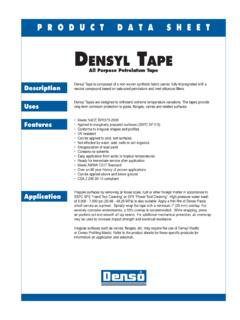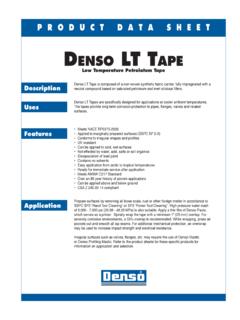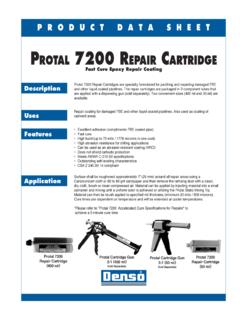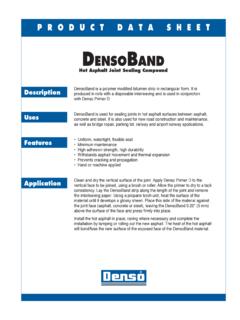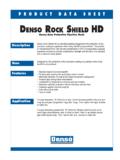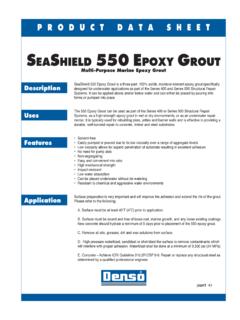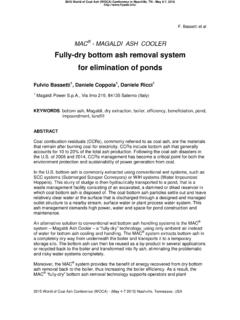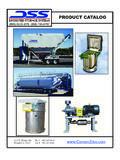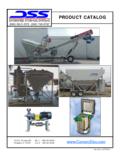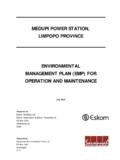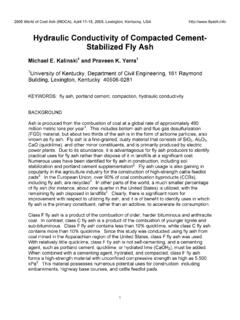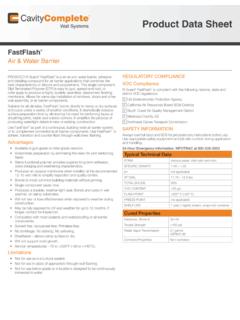Transcription of Denso Protal 7200 Brush Application Spec
1 Protal 7200 Brush Application Specifi This specifi cation covers the external surface preparation and coating of pipeline applications such as weld joints, special pipe sections, fi ttings and Material and Material shall be Denso Protal 7200 coating system as manufactured by Denso North America, 9710 Telge Road, Houston, TX 77095 (Tel) 281-821-3355 (Fax) 281-821-0304 or 90 Ironside Crescent Unit 12, Toronto, Ontario, Canada M1X1M3 (Tel) 416-291-3435 (Fax) 416-291-0898. E-mail: Material shall meet the physical properties of the attached prod-uct data sheet.
2 Storage: Material shall be stored in a warm, dry place between 40 F (4 C) to 105 F (41 C). Care shall be taken to insure the material is stored up right (arrows on boxes facing up). Note: If the material is kept cold, it will become very viscous. Do not allow material to For mixing, use strong wooden stir sticks or power drills with appropiate mixing paddle. For Application , use 4" (100 mm) wide brushes, Denso applicator pads or Protal 9" (225 mm) roller. Wet fi lm thickness Surface All contaminants shall be removed from the steel surface to be coated.
3 Oil and grease should be removed in accordance with SSPC SP-1 using non-oily solvent cleaner ( , xylene, MEK, ethanol, etc.). Material for abrasive cleaning shall be the appropriate blend of grit to produce an angular surface profi le of - 5 mils ( - mm). All surfaces to be coated shall be grit blasted to a near-white fi nish (SSPC SP-10, NACE No. 2 or Sa 2 1/2). Note: Near-white fi nish is interpreted to mean that all metal surfaces shall be blast cleaned to remove all dirt, mill scale, rust, corrosion products, oxides, paint and other foreign matter.
4 Very light shadow, very light streaks or slight discolorations shall be acceptable; however, at least 95% of the surface shall have the uniform gray appearance of a white metal blast-cleaned surface as defi ned by Swedish Pictorial Surface Preparation Standard Sa 2 1/2 or SSPC VIS-1. In some instances where abrasive blasting is not permissible, the surface can be prepared to a near-white fi nish using SSPC SP-11. The key with this method is achieving the near white fi nish with a minimum mil anchor profi le. After cleaning, blow dry and/or wipe clean with an isopropyl alcohol, xylene or MEK soaked lint-free Edges of the existing coating shall be roughened by power brushing or by sweep blasting the coating for a distance of 1" (25 mm) The Contractor shall check the surface profi le depth by using a suitable surface profi le gauge (Press-O-Film Gauge or equal).
5 Metal areas that develop fl ash rust due to exposure to rain or moisture shall be given a sweep blast to return them to their originally blasted condition. The surface shall have no condensation, precipitation or any other forms of contamination on the blasted surface prior to The substrate temperature range for Application of Protal is 50 F (10 C) to 212 F (100 C). The substrate temperature must be a minimum of 5 F (3 C) above the dew point temperature before proceeding with the coating operation. Ambient temperature may be lower than 50 F (10 C) if the substrate is heated.
6 Preheating may be accomplished with a propane torch or induction coil prior to abrasive Protal shall be applied to the specifi ed Dry Film Thickness (DFT) using a Brush , Denso applicator pad or roller. Wet fi lm measurements shall be performed to ensure close adherence to the thickness specifi Mixing: Make sure the part A (Resin) and Part B (Hardener) components match in both material and size as specifi ed on the containers. Mix the B component fi rst, independent of the resin. Pour the contents into the part A (Resin) component. Mix at a slow speed so as not to create a vortex that could introduce air into the product until a uniform color is achieved making sure to scrape the bottom and sides of the container (approximately 2 minutes).
7 No streaks shall be :9710 Telge Road,Houston, Texas, 77095 Tel: 281-821-3355 Fax: 281-821-0304 Denso NORTH AMERICAA Member of Winn & Coales :90 Ironside Crescent,Unit 12, Toronto,Ontario, Canada M1X1M3 Tel: 416-291-3435 Fax: Application SHALL TAKE PLACE IMMEDIATELY AFTER MIXING. Apply the product onto the surface and spread down and around the surface in bands beginning from the leading edge of the material to as far under the pipe as can be reached. Overlap the bands and onto the existing coating a minimum of 1" (25 mm). Applicators shall use a Brush to smooth out any obvious sags or rough edges, valleys, or drips.
8 Special attention shall be given to weld buttons and bottom surfaces. The thickness of Protal shall be checked periodically by wet fi lm gauge to achieve the minimum and maximum wet fi lm thickness specifi ed. After the Protal has cured, the owner s representative and/or contractor s inspector should measure the fi lm thickness by magnetic gauge and notify the applicator of their acceptance. Notifi cation to the applicator of any inadequately coated sections must be made Over-coating, when necessary, shall take place within 2 hours at 80 F (27 C).
9 If recoat window has lapsed, the surface shall be roughed prior to Application of the topcoat using 80 grit sand paper or by sweep Inspection/ Testing for Backfi ll The fi nished coating shall be smooth and free of runs, sags and/or holidays. All surfaces shall have the required minimum/maximum DFT. In general, the surface of the coating shall be no rougher than the base or substrate material. After the Protal has cured to a hard cure condition, the owner s representative and/or contractor s inspector should measure the fi lm thickness by magnetic gauge and notify the applicator of their For most applications , backfi ll can be accomplished when the coating reaches a Shore D of 80.
10 Using a Shore D Durometer, measure the hardness on an area of the coating that measures a minimum 30 mils DFT. Several measurements should be taken at various locations circumferentially around the pipe to ensure suffi cient An acceptable fi eld test to check to see if the coating has a full chemical cure, a solvent such as Xylene, MEK or Toluene can be rubbed on to the coating. If the gloss/sheen is removed the coating is not fully cured. Holiday detection shall be performed on all coated areas. Detection voltage should be based on specifi ed nominal pipe coating thickness and calculated in accordance with the NACE SPO188 Denso and/or the owner s representative immediately upon completion of the work shall make fi nal inspection of the completed Application .
